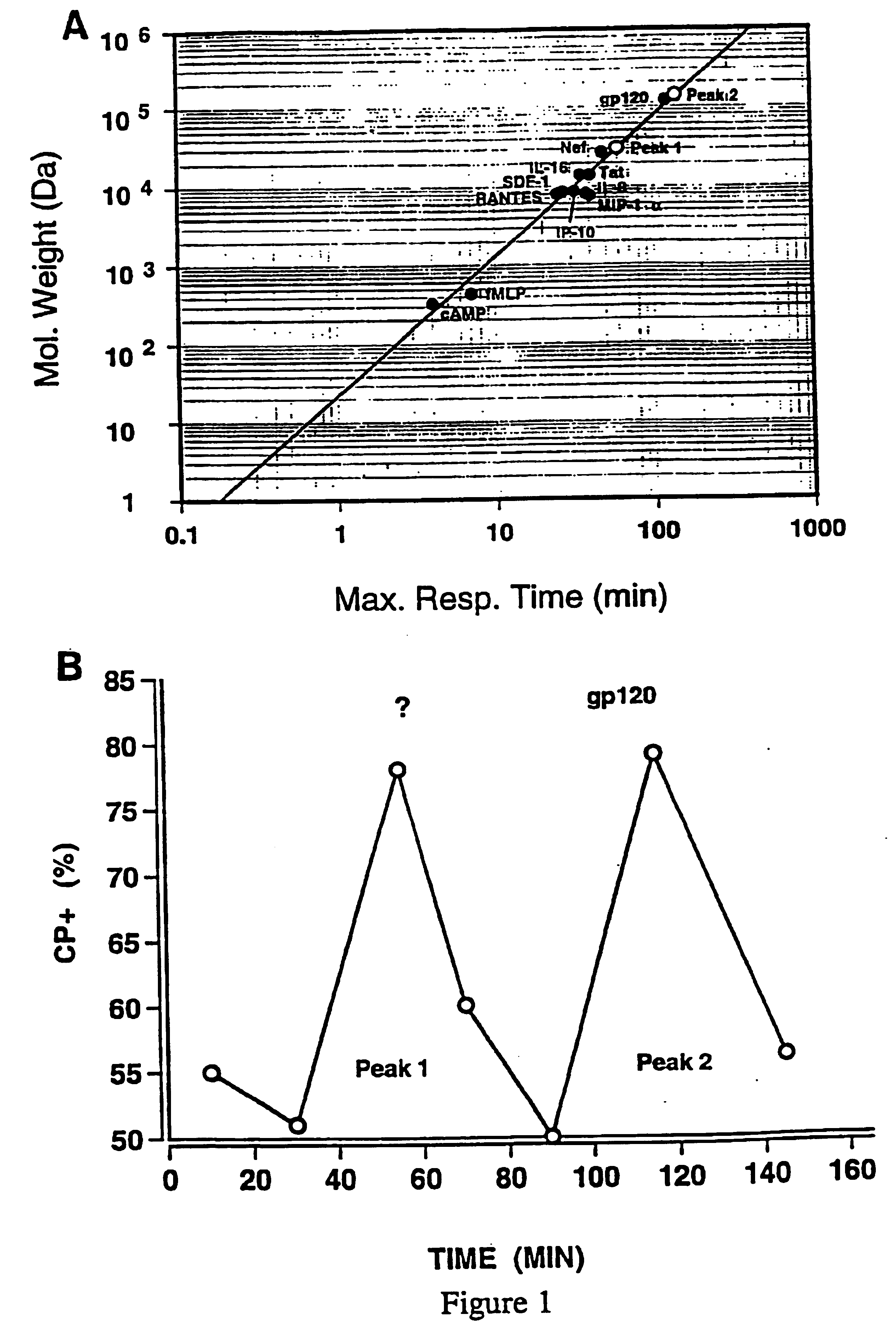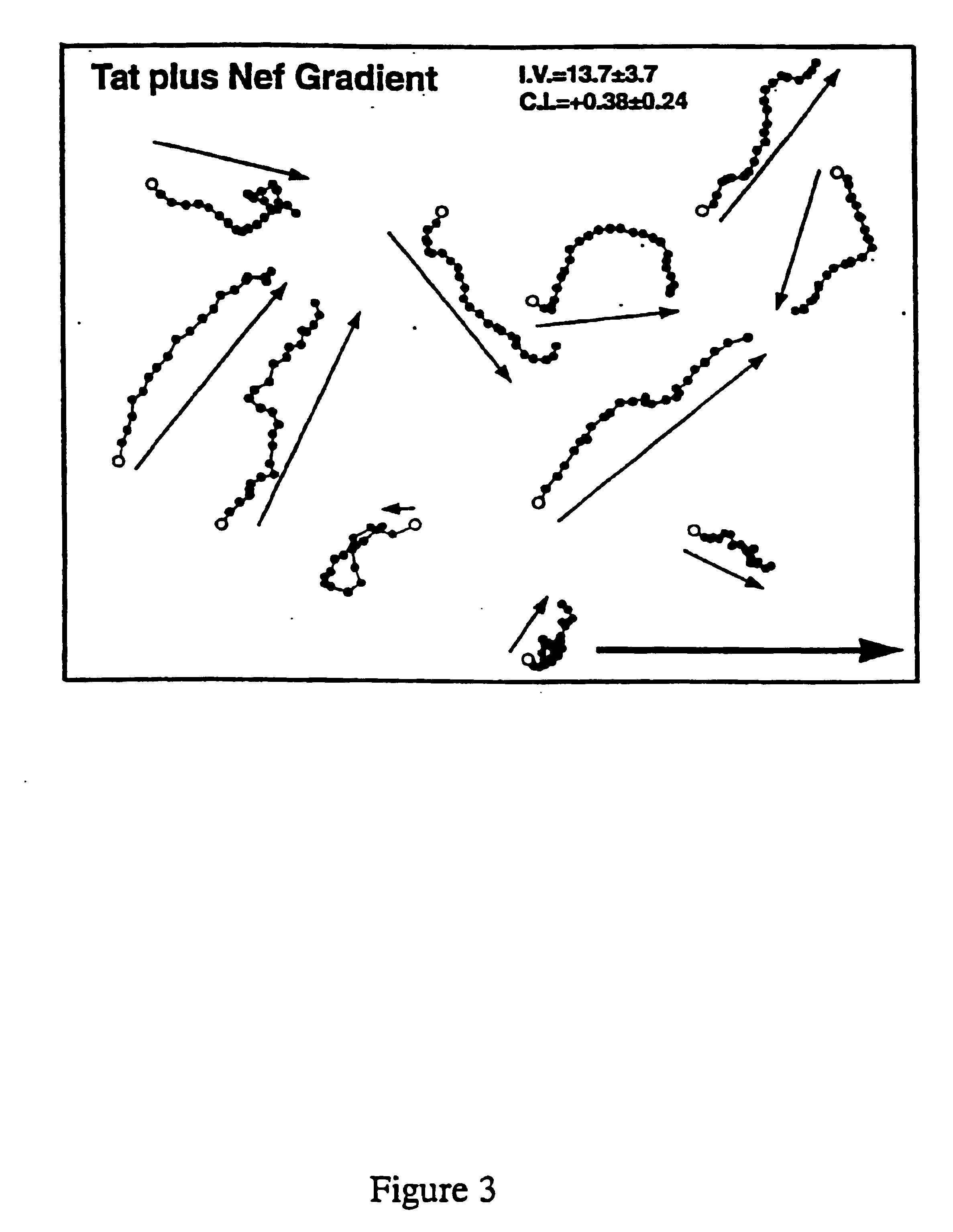HIV-encoded chemoattractant
a chemoattractant and encoded technology, applied in the field of hivencoded chemoattractants, can solve the problems of tissue destruction, unwanted inflammatory response, complicating the distinction between a chemotactic and a chemokinetic effect, etc., to achieve the effect of improving stability and persistence, facilitating purification, and relatively easy and inexpensive production
- Summary
- Abstract
- Description
- Claims
- Application Information
AI Technical Summary
Benefits of technology
Problems solved by technology
Method used
Image
Examples
example 1
Preparation and Culture of T Cells
To obtain a highly enriched culture of CD4+ peripheral blood T cells, 250 ml of fresh blood was drawn from a healthy, HIV-negative donor into heparinized syringes. 31 ml were overlaid on 15 ml of Ficoll-Hypaque cushion solution in each of eight 50 ml conical tubes. The tubes were centrifuged 40 min at 550×g, and the band of mononuclear cells atop each cushion was retrieved and pooled into a fresh 50 ml conical tube. The cells were pelleted at 1,000×g for 10 min and washed 3 times in Earle's Balanced Salts Solution (EBSS). The final pellet was resuspended in 40 ml of RPMI 1640 (Gibco) supplemented with 10% heat-inactivated fetal bovine serum (FBS), 2 mM L-glutamine, 1×MEM non-essential amino acid solution, 1 mM sodium pyruvate, 100 U / ml penicillin and 100 μg / ml streptomycin sulfate. The cell suspension was transferred to a T-75 culture flask and incubated for 2 h at 37° C. in 5% CO2. Non-adherent cells were transferred to a 50 ml conical tube, gently...
example 2
Infection with HIV and Obtaining Syncytium-Conditioned Supernatant
HIV-1LAI (previously referred to as HTLV-IIIB) was passed in cell cultures according to methods previously described. Harada et al. (1985). For infection, 107 SupT1 cells were pelleted, resuspended in 1 ml of infected culture supernatant containing 500 TCID50 doses of HIV-1LAI, and incubated for 2 h. Parallel mock infections were performed by resuspending the cells in medium without virus. After incubation, cells were diluted with fresh medium. To obtain syncytium-conditioned supernatant, 72 to 96 hour post-infected cultures were placed on the stage of an inverted microscope inside a biosafety cabinet, and individual syncytia were picked with a micropipettor and placed in a 1.5 ml screw cap tube with fresh medium. The syncytia conditioned the media for 6 hours, after which time the syncytia were centrifuged and the supernatant was removed to a fresh tube and stored at −80° C.
example 3
Setting up the Chemotaxis Chamber
Cultures of SupT1 or CD4+ blood cells were grown to a density of 1×106 cells / ml, and 200 μl of the culture were seeded onto the centers of 22×30 mm THERMANOX® plastic coverslips inside of plastic petri dishes, and were incubated overnight. This step conditioned the surface of the coverslip, increasing the proportion of motile cells approximately four-fold. Inside the biosafety cabinet, excess medium was removed from the coverslip, and the conditioned side of the coverslip was placed onto the center of the chamber and clamped down. The chamber was then inverted so that cell motility could be measured by their movement over the conditioned, plastic coverslip. The source and sink wells were simultaneously filled with the test solutions indicated below. “EBSS” is Earle's Balanced Salt Solution. “Nhs” is normal human serum. “SCM” is medium conditioned by HIV-induced syncytia. “Cond. Med.” is medium conditioned by uninfected cells. A glass coverslip was pl...
PUM
| Property | Measurement | Unit |
|---|---|---|
| Cell angle | aaaaa | aaaaa |
| Antimicrobial properties | aaaaa | aaaaa |
Abstract
Description
Claims
Application Information
 Login to View More
Login to View More - R&D
- Intellectual Property
- Life Sciences
- Materials
- Tech Scout
- Unparalleled Data Quality
- Higher Quality Content
- 60% Fewer Hallucinations
Browse by: Latest US Patents, China's latest patents, Technical Efficacy Thesaurus, Application Domain, Technology Topic, Popular Technical Reports.
© 2025 PatSnap. All rights reserved.Legal|Privacy policy|Modern Slavery Act Transparency Statement|Sitemap|About US| Contact US: help@patsnap.com



